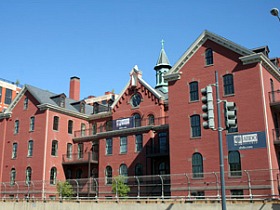 Gentrification in DC: Five Takeaways From a Recent Forum
Gentrification in DC: Five Takeaways From a Recent Forum
✉️ Want to forward this article? Click here.

Former Children’s Museum, now Mayor’s condo.
How can policy makers in DC influence the gentrification process? Do market forces make it inevitable? Do residents have any way to enter the conversation?
On Thursday night, Tabaq Bistro on U Street was packed with residents eager to discuss these questions at the DC Humanities Council’s latest panel discussion: Is it Renaissance or Gentrification? Examining the Role of Public Policy and Economic Development. The panelists included architects and Historic Preservation Review Board members Maria Casarella and Rauzia Ruhana Ally, Washington Post reporter Jonathan O’Connell and former Mayor Anthony Williams, who put into place several of the policies that led to DC’s significant growth over the last decade.
While the discussion meandered from topic to topic, here are a few of the most interesting ideas that we heard.
- Cities should be messy. “I don’t think the founders intended for the city to be a shrine to government. I think they intended it to be a living, breathing city,” said Mayor Williams. “Part of being in a city is being in a messy place — a little chaos is good!” Perhaps, thought Williams, DC should consider the possibility of allowing billboards in some areas of the city. He also questioned the hesitancy to have any visible streetcar lines.
- The Children’s Museum is now a high-end condo. Is that bad? Mayor Williams was one of the first residents in Landmark Lofts, a condo project in what used to be the Children’s Museum on gentrifying H Street. The discussion came back to this fact several times. An audience member bemoaned the loss of the Children’s Museum and questioned the good of the high-end development. Williams defended the move, stating that creating mixed-income neighborhoods should be the goal of gentrification at the same time displacement should be carefully avoided. “I ride the bus down H Street every day,” said Williams. “If a little boy sees a bald guy who used to be Mayor reading a pink paper on the bus, he’ll ask his mom, ‘What is he reading?’ She’ll say, ‘Oh, it’s the Financial Times.’ That is a good role model.” O’Connell pointed out that the museum was not pushed out, but made the active decision to leave DC and move to the National Harbor. While they may regret the decision, thought O’Connell, it was not the force of gentrification that pushed them out.
- ANC meetings are underutilized. As UrbanTurf knows (from hours of attending them), ANC meetings are a great place for community members to have an impact on the development that goes on in their neighborhood. And yet, they are also often under-attended. “ANCs are given great weight by the HPRB,” said Casarella. “If you really want to get involved, the process is there,” she said, pushing back against murmurs from the audience that they felt shut out of the development process. Casarella gave the example of the massive Walter Reed development, which is going through the HPRB process this fall. Developers have been meeting with the community for years as they adjust the plans. “The more active the community groups are, the more effective the plan will be.”
- Inclusionary zoning is not a cure-all. DC’s inclusionary zoning policy mandates that a certain portion of new residential construction be set aside of low-income residents. It is generally regarded as an effective way to keep neighborhoods mixed-income, but The Post’s O’Connell warned that the practice is not a cure-all. “The costs of inclusionary zoning can be enormous,” he said, mentioning that luxury condo developments, such as CityCenter‘s residences, which will cost as much as $700,000, must set aside some percentage of affordable units at a huge cost to the developer. Perhaps the developers could instead contribute the money saved back into the community. O’Connell wondered is a tool such as DC’s Housing Production Trust Fund, which allocates funds towards producing and preserving affordable housing units, may be a more flexible way to ensure mixed-income neighborhoods and to support low-income residents.
- DC’s growth is partly a result of national trends. O’Connell noted that the country experienced a few trends — a renewed interest in public transit rather than driving, a move toward smaller urban homes, and favoring where one lives over what they live in — just as DC was having its development boom. “Washington has been able to take advantage of that better than any other city,” stated O’Connell.
This discussion was the last in the Humanities Council’s Humanitini series.
Similar Posts:
See other articles related to: anthony williams, dclofts, gentrification, jonathan o'connell
This article originally published at http://dc.urbanturf.production.logicbrush.com/articles/blog/gentrification_in_dc_five_takeaways_from_a_recent_forum/6092.
Most Popular... This Week • Last 30 Days • Ever

With frigid weather hitting the region, these tips are important for homeowners to ke... read »

Today, UrbanTurf offers a brief explanation of what it means to lock in an interest r... read »

A new report from DC’s Office of Revenue Analysis highlights how millennials and wo... read »

The 30,000 square-foot home along the Potomac River sold at auction on Thursday night... read »

An application extending approval of Friendship Center, a 310-unit development along ... read »
DC Real Estate Guides
Short guides to navigating the DC-area real estate market
We've collected all our helpful guides for buying, selling and renting in and around Washington, DC in one place. Start browsing below!
First-Timer Primers
Intro guides for first-time home buyers
Unique Spaces
Awesome and unusual real estate from across the DC Metro














